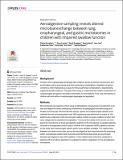Aerodigestive sampling reveals altered microbial exchange between lung, oropharyngeal, and gastric microbiomes in children with impaired swallow function
Author(s)
Duvallet, Claire; Alm, Eric J.
DownloadPublished version (1.713Mb)
Publisher with Creative Commons License
Publisher with Creative Commons License
Creative Commons Attribution
Terms of use
Metadata
Show full item recordAbstract
Background Children with oropharyngeal dysphagia have impaired airway protection mechanisms and are at higher risk for pneumonia and other pulmonary complications. Aspiration of gastric contents is often implicated as a cause for these pulmonary complications, despite being supported by little evidence. The goal of this study is to determine the relative contribution of oropharyngeal and gastric microbial communities to perturbations in the lung microbiome of children with and without oropharyngeal dysphagia and aspiration. Methods We conducted a prospective cohort study of 220 patients consecutively recruited from a tertiary aerodigestive center undergoing simultaneous esophagogastroduodenoscopy and flexible bronchoscopy. Bronchoalveolar lavage, gastric and oropharyngeal samples were collected from all recruited patients and 16S sequencing was performed. A subset of 104 patients also underwent video fluoroscopic swallow studies to assess swallow function and were categorized as aspiration/no aspiration. To ensure the validity of the results, we compared the microbiome of these aerodigestive patients to the microbiome of pediatric patients recruited to a longitudinal cohort study of children with suspected GERD; patients recruited to this study had oropharyngeal, gastric and/or stool samples available. The relationships between microbial communities across the aerodigestive tract were described by analyzing within- and between-patient beta diversities and identifying taxa which are exchanged between aerodigestive sites within patients. These relationships were then compared in patients with and without aspiration to evaluate the effect of aspiration on the aerodigestive microbiome. Results Within all patients, lung, oropharyngeal and gastric microbiomes overlap. The degree of similarity is the lowest between the oropharynx and lungs (median Jensen-Shannon distance (JSD) = 0.90), and as high between the stomach and lungs as between the oropharynx and stomach (median JSD = 0.56 for both; p = 0.6). Unlike the oropharyngeal microbiome, lung and gastric communities are highly variable across people and driven primarily by person rather than body site. In patients with aspiration, the lung microbiome more closely resembles oropharyngeal rather than gastric communities and there is greater prevalence of microbial exchange between the lung and oropharynx than between gastric and lung sites (p = 0.04 and 4×10-5, respectively). Conclusions The gastric and lung microbiomes display significant overlap in patients with intact airway protective mechanisms while the lung and oropharynx remain distinct. In patients with impaired swallow function and aspiration, the lung microbiome shifts towards oropharyngeal rather than gastric communities. This finding may explain why antireflux surgeries fail to show benefit in pediatric pulmonary outcomes.
Date issued
2019-05-20Department
Massachusetts Institute of Technology. Department of Biological Engineering; Massachusetts Institute of Technology. Center for Microbiome Informatics and TherapeuticsJournal
PLoS one
Publisher
Public Library of Science (PLoS)
Citation
Duvalle, Claire et al. "Aerodigestive sampling reveals altered microbial exchange between lung, oropharyngeal, and gastric microbiomes in children with impaired swallow function." PLoS one 14 (2019): e0216453 © 2019 The Author(s)
Version: Final published version
ISSN
1932-6203
Keywords
General Biochemistry, Genetics and Molecular Biology, General Agricultural and Biological Sciences, General Medicine